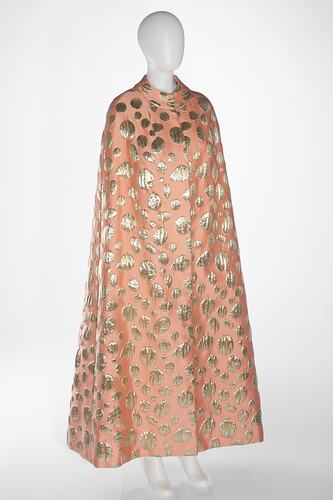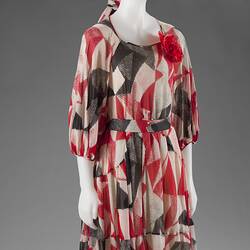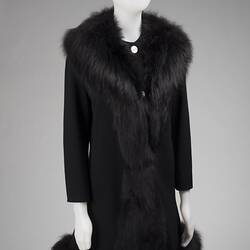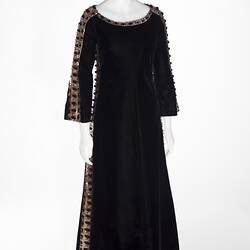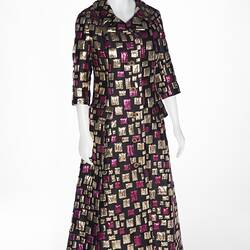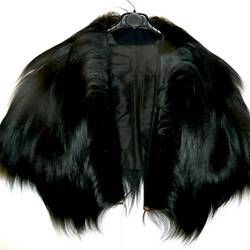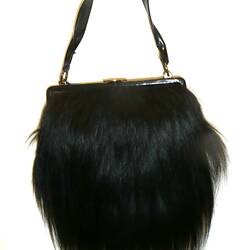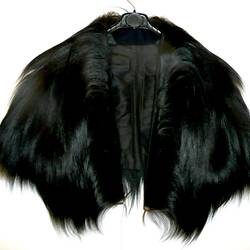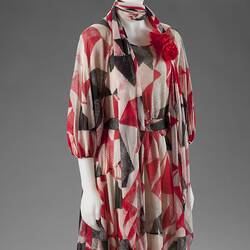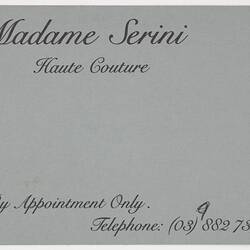Irredenta Itala Serini was born in 1918 in Fiume, then part of Italy and now part of Croatia. Daughter of a renowned sculptor, Antonio Mareitti, she was trained from the age of 14 in fashion design and dressmaking by Miss Bobeylshek, a Viennnese cutter and dressmaker. At the age of 29 she moved from Fiume to Milan, where she stayed for three years and established a reputation as a designer and dressmaker. Her work was often commissioned by the House of Lecomte, and she became feted as a society dressmaker.
In 1950 Itala boarded a ship with her husband and young family, seeking a better life in Australia. The family stayed in Bonegilla on their arrival in Victoria. After three months they moved to Hobart, where Itala began work for Claudio Alcorso, who owned a textile factory in partnership with Paul Sonnino. Both were pre-war Italian immigrants who had been interned in South Australia during World War II. Itala became their leading fashion designer, and was introduced to Hobart's society women. She was soon the city's most sought-after designer and dressmaker, and set up the Itala Model Salon. Her daughter and sister - who she sponsored to immigrate - became her favourite models. She advertised for a 'skilled sewing assistant' or apprentice in October 1950, listing the adddress 32 Red Chapel Rd, Sandy Bay (the Mercury, 25 Oct 1950, p.24),
One of her clients, Mrs Turnbull, wife of the Minister for Health, John Turnbull, suggested she try the Melbourne market. Mrs Turnbull gave her a letter of introduction, and Itala and her husband flew to Melbourne. Itala worked her way along the Collins Street fashion stores until arriving at Le Louvre, at 74 Collins Street. Le Louvre had opened in 1922 and was one of Melbourne's leading fashion houses; it remains in business to this day, now located in South Yarra. The owner, Lilian Wightman, allowed Itala to show some of her work, and was so impressed she immediately placed an order.
Itala and her husband returned to Hobart, but in December 1953 Lilian persuaded them to move to Melbourne, and asked for the exclusive rights to sell Itala's work. The Serinis moved into an apartment in Middle Brighton, from which Itala designed and made her garments, with the assistance of other women, many of Italian origin. She designed many outfits for the visit of Queen Elizabeth II to Melbourne in 1954. As business boomed, the family moved to a large house in Toorak, where Itala continued to make clothes. Soon afterwards Lilian asked her to move with some of her workers to the workshop of Le Louvre in Collins Street.
Almost 10 years after migrating to Australia, Itala and her daughter returned to Italy for a six-month visit. During that time, a Sydney designer took over her role at Le Louvre, such was the competitive nature of the business. This became the trigger for her establishing her own salon in 1959: Madame Serini Haute Couture, at 484 Toorak Road, Toorak. It was opened by the Italian Counsul-General, Marchese Giorgio Serafini.
Itala actively promoted the salon, travelling the country, conducting fittings and arranging newspaper promotions. Her label was soon considered the best of the best European fashion in Australia. Itala believed that quality was a strong factor in 'real style'. Her fabrics were sourced from Europe - mainly Italy and France - and even her linings were made of quality materials such as silk. She was an astute businesswoman, who managed all parts of the business, including publicity and costings. She even added an 'haute couture school of cutting and sewing classes for beginners' to the offerings at the Madame Serini salon.
Itala was widowed in 1966, when her husband died of a heart attack at the age of 50. The business continued to grow, however, and reached its heyday in the early 1970s, when there was a strong market for personally-tailored clothing and an interest in high fashion styles.
As the 1970s progressed, however, anti-high fashion trends undermined the business, and the salon closed in 1981. Itala continued to design and make clothes for a restricted clientele for many years. She passed away in 2006.
The Italian Historical Society - COASIT - holds scrapbooks and images documenting Madame Serini's life and work: http://www.coasit.com.au/IHS/collection.html#photographic
References:
Astrid Haban-Beer, 'Recalling the Memories of an Haute Couturiere: Madame Serini - a Journey from Fiume to Melbourne', Italian Historical Society Journal, vol.12, no.1, Jan-June 2004, pp. 25-30
Interviews, Madame Serini, conducted by the Italian Historical Society (COASIT), 12 October 1987 and 12 November 2003
Advertising (1952, May 3). The Mercury (Hobart, Tas. : 1860 - 1954), p. 23. Retrieved December 21, 2016, from http://nla.gov.au/nla.news-article27086619
Advertising (1950, October 25). The Mercury (Hobart, Tas. : 1860 - 1954), p. 24. Retrieved March 16, 2017, from http://nla.gov.au/nla.news-article26735711
More Information
-
Keywords
Fashion Design, Cultures and histories : Melbourne and Victoria, immigration
-
Authors
-
Article types
